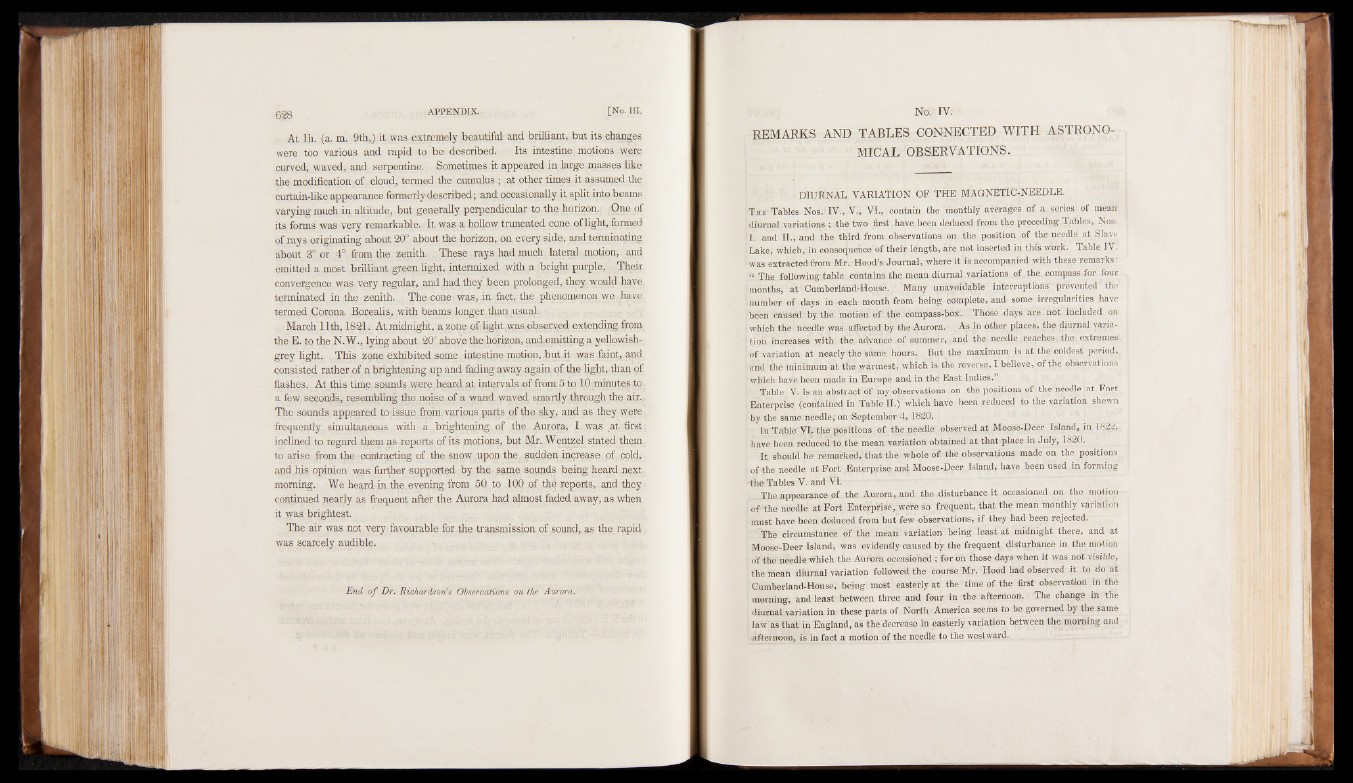
At lh. (a. m. 9th,) it was extremely beautiful and brilliant, but its changes
were too various and rapid to be described. Its intestine, motions,,were
curved, waved, and serpentine. Sometimes it appeared in large masses like
the modification of cloud, termed the cumulus ; at other times it assumed the
curtain-like appearance formerly described; and occasionally it split into beams
varying much in altitude, but generally perpendicular to the horizon. One oi'
its forms was very remarkable. It was a hollow truncated cone of light, formed
of rays originating about 20° about the horizon, on every side, and terminating
about 3° or 4° from the zenith. These rays had much lateral motion, and
emitted a most brilliant green light, intermixed with a bright purple, Their
convergence was very regular, and had they been prolonged, they.would have
terminated in the zenith. The.cone; was, in fact, the phenomenon we have
termed Corona Borealis, with beams longer than iusual.
March 11th, 1821: Atmidnight, a zone of light, was observed extending from
the E. to the N.W., lying about 20° above the horizon, and,emitting a yellowish-
grey light. This zone exhibited some intestine motion, but it was faint, and.
consisted rather of a brightening up and fading away again, of the light, than of
flashes. At this time sounds were heard at intervals of from 5 to 10 minutes,to
a few seconds, resembling the, noise of a wand waved smartly through the, air.,
The sounds appeared to issue from various parts of the sky, and as they were,
frequently simultaneous with a, brightening, of the, Aurora, I was at first
inclined to regard than as reports of its motions, but Mr. Wentzel stated them,
to arise from the contracting of the snow upon the . sudden increase, of) cold,
and his opinion was.further supported by the.spae soupds being heard next
morning. We heard-in the,evening from.. 50 to 100 of the reports, and they
continued nearly as frequent after the Aurora had almost faded away, as when
it was brightest.
The air was not very favourable for the-transmission of sound, as the rapid
was scarcely audible: ..
End of Dr. Richardson's Observations on the Aurora.
REMARKS AND TABLES CONNECTED WITH ASTRONOMICAL
OBSERVATIONS.
DIURNAL VARIATION OF THE MAGNETIC-NEEDLE.
T he Tables Nos. IV., V., VL, contain the monthly averages of a series of mean
diurnal variations ; the two first have been deduced from the preceding Tables, Nos.
I. and II., and the third from observations on the position of the needle at Slave
Lake, which, in consequence of their length, are not inserted in this work. Table IV.
was extracted from Mr. Hood’s Journal, where it is accompanied with these remarks.
« The following table contains the mean diurnal variations of the compass for four
months, at Cumberland-House. Many unavoidable-interruptions prevented the-
number of days in each month from being complete, and some irregularities have
been caused by the motion of the. compass-box. Those days are not included on
which the needle was affected by the Aurora. As in other places, the diurnal variation
increases with the advance of summer, and the needle reaches; the extremes',
of variation at nearly the same hours. But the maximum is at the coldest period,
and thé minimum at the warmest, which is the reverse, I believe, of the observations
which have been made in Europe and in the East Indies.”
Table V. is an abstract of my observations on the positions of the needle at Fort
Enterprise (contained in Table II.) which have been reduced to the variation shewn
by the same needle,” on September 4, 1820.
In Table VL the positions of the needle observed at Moose-Deer Island, in 1822,
have been reduced to the mean variation obtained at that place in July, 1820.
It should be remarked, that the w hole of the observations made on the positions
i of the needle at Fort Enterprise and Moose-Deer Island, have been used in. forming
the Tables V. and VI.
The appearance of the Aurora, and the disturbance it occasioned on the motion
of the needle at Fort Enterprise, were so frequent, that the mean monthly variation
must have been deduced from but few observations, if they had been rejected.
The circumstance of the mean variation being least at midnight there, and at
Moose-Deer Island, was evidently caused by the frequent disturbance in the motion
of the needle which the Aurora occasioned ; for on those days when it was not visible,
the mean diurnal variation followed the course Mr. Hood had observed if to do at
Cumberland-House, being most easterly at the time of the first observation in thé
morning, and least between three and four in the afternoon. The change in the
diurnal variation in these parts of North America seems to be governed by the same
law as that in England, as the decrease in easterly variation between the morning and
afternoon, is in fact a motion of the needle to the westward.